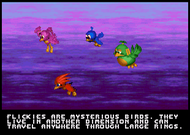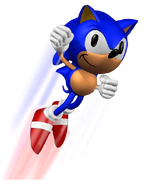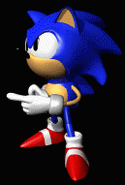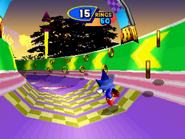Sonic 3D Blast (titled Sonic 3D: Flickies' Island or Sonic 3D in Europe, Australia and New Zealand) is an isometric platform game in the Sonic the Hedgehog series. It was developed in the United Kingdom by Traveller's Tales and published by Sega. The Japanese version was a Sega Saturn exclusive. The Genesis (or Mega Drive) version has been released on the Wii's Virtual Console service in late 2007 on the European and Japanese markets, and in November 19, 2007 for North America.
Archie Comics published a comic adaptation of the game for a 48-page special, published in January 1997. A loose adaptation of the game also appeared in issues #104-106 of Sonic the Comic.
The North American title Sonic 3D Blast should not be confused with the game Sonic Blast for the Sega Game Gear.
Release history and versions
In addition to the original Mega Drive version, Sonic 3D was also available for the Sega Saturn to make up for the cancellation of Sonic X-treme, which was intended to be Saturn's killer game for the 1996 holiday season; the game was ported in seven weeks, during development of the Mega Drive version. The game boasts FMVs, higher quality graphics (including a true 3D Special Stage, considered by many fans to be the best Special Stage in the series) and an entirely new CD audio soundtrack composed by Richard Jacques (who later produced the Sonic R soundtrack). A European release followed in February 1997.
In September 1997 a port of the Saturn version was released for PC in Europe and North America, with the videos and soundtrack intact, as well as the notable addition of a save game system, but lacking some of the Saturn's effects (such as the fog in Rusty Ruins) and with a less impressive special stage that mixed the 2D sprites from the Mega Drive version with the basic gameplay of the Saturn version. The Saturn version was eventually released in Japan on October 14, 1999, the same date as Sonic Adventure International. That release is notable for including stylized "Classic Sonic" artwork, but other than that the game is largely identical except the load times are slightly improved.
Only one version of the Mega Drive game was released, with the title differing depending on whether it is played on a PAL or NTSC console. In PAL regions the title is Sonic 3D: Flickies' Island, and in NTSC regions the title is Sonic 3D Blast. This caused a problem, however, when the Mega Drive version was re-released in the Sonic Mega Collection. Due to the aforementioned feature, the game is titled Sonic 3D Blast when played on a PAL 60 or NTSC-J system.
Although the PC version's title differed between regions, its executable was titled Sonic 3D Blast: Flickies' Island, a combination of both names. It should be noted though, that the combined name is rarely used, with fans usually favoring one name over the other. In addition, Sonic 3D: Flickies' Island was the title that was used for the Japanese Saturn version, but when the Mega Drive version was finally released in Japan as part of Sonic Mega Collection, it was once again known as Sonic 3D Blast.
In October 2006, a 95 percent complete prototype was acquired and dumped for Internet distribution.[3]
Story
Dr. Robotnik discovers that some strange birds, called Flickies, reside on a secluded island in the ocean. He learns that they are native to a different dimension, and can travel between worlds using large rings. Consequently, the Doctor resolves to turn them all into robots, to help him search for the Chaos Emeralds. One day, Sonic visits Flickies' Island and sees what Robotnik has done to the birds. Naturally, he decides to free the Flickies and stop Robotnik from finding the Emeralds.
Zones
Sonic 3D includes seven main Zones plus a final boss level. In order, the stages are:
- Green Grove Zone, a Green-Hill-esque tropical paradise with checkered soil.
- Rusty Ruin Zone, the once-submerged remnants of an ancient culture, dredged up from the sea bed by Robotnik.
- Spring Stadium Zone, a bouncy arena filled with balloons and spikes.
- Diamond Dust Zone, the frigid slopes of Flickies' Island's mountain range.
- Volcano Valley Zone, an active volcano.
- Gene Gadget Zone, Robotnik's genetic research laboratory.
- Panic Puppet Zone, a fortified factory and the center of Robotnik's base.
- Final Fight, the steel foundations beneath Panic Puppet.
Music and audio

Sonic 3D Blast's (US) title screen when put into a Sega Genesis.

The title screen of the European Sega Saturn version.
Example of gameplay
Several music tracks from the Mega Drive version were later reused in Sonic Adventure. This is not a coincidence, as Jun Senoue worked on the music for both games. Richard Jacques scored the Saturn/PC versions. Many of the themes used in the Mega Drive version come from Sonic the Hedgehog 3 and Sonic & Knuckles. The Game Over music was also used in Sonic Pocket Adventure. A version of the Panic Puppet Zone theme was used in the games Shadow the Hedgehog (GameCube, PlayStation 2, Xbox) and Sonic Chronicles: The Dark Brotherhood (Nintendo DS). Furthermore, hidden in the cartridge data (not accessible from the sound test screen) is the music track from Sonic 3's gumball bonus stage, which was also composed by Jun Senoue. Since the Saturn and PC versions of the game use Red Book audio, their soundtracks can be played using a CD player.
The Saturn version also features a theme song, "You're My Hero", composed by Richard Jaques and performed by Debbie Morris. This song is heard during the game's end credits.
Gameplay
The game is played from an isometric viewpoint in a 2D environment and uses pre-rendered 3D sprites. Sonic must collect Flickies (first featured in the 1984 Sega arcade game Flicky) and bring them to a warp ring in order to advance in a zone. Each zone consists of two regular acts and one boss act. There are 10 or 15 Flickies in each zone's regular acts, barring Panic Puppet's, while in each zone's third act the player faces Dr. Robotnik in one of his many machines.
Chaos Emeralds
- See also: Special Stages (Sonic 3D)
The Chaos Emeralds seen in the Mega Drive version are Emerald cut instead of the usual Brilliant cut. (Coincidentally, the Sol Emeralds from the Sonic Rush games are also Emerald cut.)
To warp to a bonus level where the player can try for a Chaos Emerald, either Knuckles or Tails must be located within the regular levels. The player must have 50 rings or more, and must stand next to either Tails or Knuckles. At this point, the player's rings will be absorbed, and the played will be transported to the Chaos Emerald level.
There are three different versions of the bonus levels.
- Sega Genesis: Sonic must run down a bridge, collecting rings and avoiding bombs.
- Sega Saturn: Sonic must run down a three dimensional half-pipe covered in rings and bombs and must collect enough rings to progress to the end of each stage.
- PC Version: Sonic must run down a half-pipe similar to those in Sonic the Hedgehog 2 (16-bit).
Flicky Types

The eponymous Flickies of Flickies' Island
The Flickies Sonic rescues in each level come in four different colors. Each color has its own personality:
- Blue Flickies make a conscious effort to find Sonic. If they cannot find him, they fly around in a tight circle, making them easy to locate.
- Pink Flickies act largely like blue ones, but fly around in bigger circles if unable to find Sonic. In the Volcano Valley Zone in the Genesis version, the pink Flickies are replaced with bright orange, flaming Flickies, presumably due to color palette limitations.
- Red Flickies constantly move between two close points, not making any effort to find Sonic. Their movement range is small, but they jump very high and can thus be hard to catch.
- Green Flickies wander randomly with no interest in finding Sonic, they even sometimes appear to try to avoid Sonic.
Bosses
At the third act of each zone, Sonic will encounter Doctor Robotnik in his machines, which require various amounts of hits to defeat.
- Eggmobile (spike ball dropper) (Green Grove)
- Eggmobile (armored) (Rusty Ruin)
- Eggmobile (spike hands) (Panic Puppet)
- Eggmobile (freeze mobile) (Diamond Dust)
- Eggmobile (lava machine) (Volcano Valley)
- Eggmobile (missile launcher) (Gene Gadget)
- Eggmobile (multipurpose arm weapon) (Panic Puppet)
- Final Fight (If all Chaos Emeralds are collected)
Trivia
- This is the second game to feature Knuckles' socks being the wrong color, as they are blue instead of green. The first game to see this was in Sonic 3 & Knuckles where they were yellow when not playing as Knuckles.
- At Jack in the Box fast food restaurants, copies of this game were given away as bonuses in kids' meals, up until the release of Sonic Adventure.
- The names of the stages in this game are all alliterations like the stages in Sonic CD.
- The music for Panic Puppet Zone act 1 on the Mega Drive was remixed in Sonic Adventure for Twinkle Park, the Green Groove Zone Act 1 music was also remixed in Sonic Adventure for "The Air" in Windy Valley, the Bonus Stage music is used, albeit in a much slower form, in the first stage of Windy Valley, "Windy Hill", before the Tornado, and Diamond Dust Zone's music would be re-used in Sonic Chronicles.
- This is the second game where collecting all the Emeralds does not unlock Super Sonic.
- This is the last Sonic game on the Mega Drive/Genesis.
- This game was Travelers Tales first developer appearance, then later Travelers Tales returned for Sonic R for its last development.
- One of Sonic's waiting animations in this game appears in Sonic Generations as one of Classic Sonic's waiting animations.
- The stage music of Diamond Dust Zone (Mega Drive version) also appears in Sonic Generations as an unlockable music track.
- An unused track for a pre-release version of Sonic 3D was later used as the initial boss theme in Sonic the Hedgehog 4: Episode I.
- The Japanese version on Sega Saturn has slightly faster loading times, but removed (or changed) the level skip code.
- It was the third to last first-party Saturn game released in Japan, where it was a Saturn exclusive until the release of Sonic Mega Collection which finally brought the Mega Drive version to Japan. It was also the last Sonic game for the Mega Drive.
- In the Panic Puppet Zone at Act 2, if one listens closely, the music is more like a remix of the boss battle in Sonic the Hedgehog 3 and Sonic and Knuckles.
Box Art
Artwork
2D Artwork
3D Artwork
Screenshots
Sega Genesis
Sega Saturn
Reference
- ↑ Quote from Producer of Sonic 3D Blast Mike Wallis: They were part of the backup plan with Sonic 3D Blast, and Travellers Tales did the game and SOJ did the Bonus Levels (Special Stages)[1]
- ↑ According to Programmar Jon Burton, Sega actually “supplied the game design and level layouts, so we (Traveller's Tales) implemented the gameplay, created the technology to run that kind of game on a Mega Drive and created the rendered graphic style and so on,” he recalls.[2].
- ↑ Sonic 3D Beta website
External links
- Sonic 3D Blast Nintendo site
- Sonic 3D review at Gamespot.











